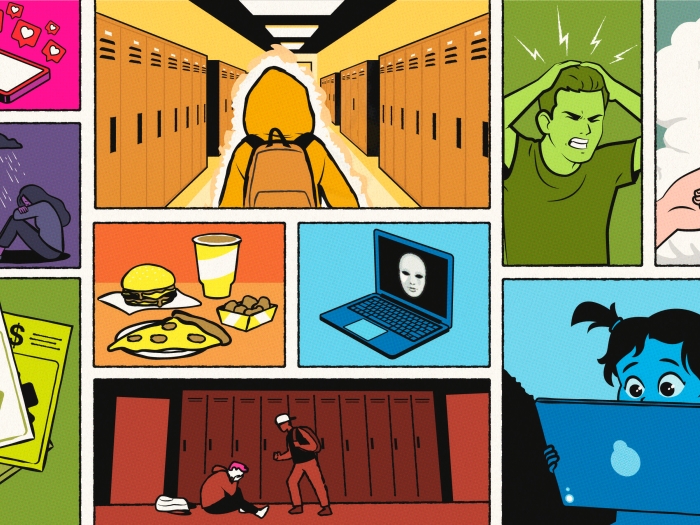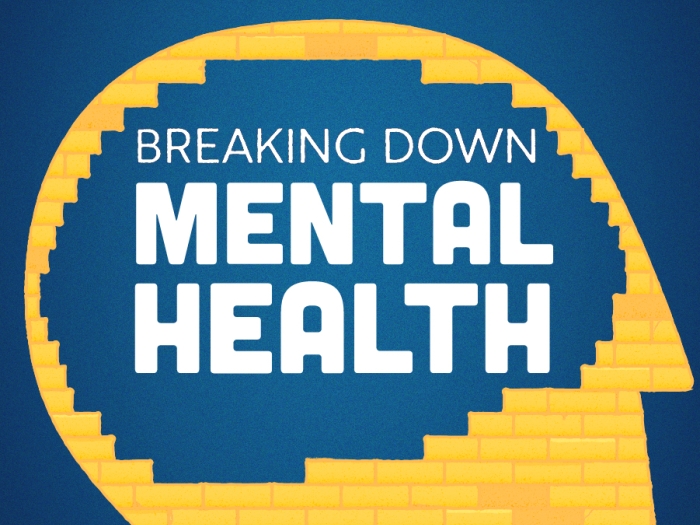Episode 1
Featured guest: Victor Hong, M.D., Department of Psychiatry
This episode will provide an overview of the mental health system in Michigan and the US. The current mental health crisis will also be explored, including strategies health professionals can use those with mental illness experiencing a psychiatric crisis.
Objectives:
- Describe the current mental health crisis (in Michigan and the US)
- Apply knowledge of the mental health system to patient care
- Define what different levels of mental health care are
Resources:
- Practicing child and adolescent psychiatrists by state (AACAP)
- Beyond a bigger workforce: Addressing the shortage of child and adolescent psychiatrists (Nationwide)
- Nurse practitioner scope of practice by state (Georgetown)
- NP state practice environment map (AANP)
- A closer look: Inpatient psychiatric beds for kids and teens in Michigan lacking (Fox 47 News)
- Navigating a mental health crisis (NAMI)
CME:
Credits available: 0.50
Visit our CME course overview page for CME credit, or complete this survey for social work CEUs.
Transcript
Dr. Christina Cwynar:
Hello and welcome to our podcast Breaking Down Mental Health with myself, nurse practitioner, Dr. Christina Cwynar, child and adolescent psychiatrist, Dr. Heidi Burns, and social worker, Syma Khan. Before we launch into today's topic about the state of mental health, we would like to introduce ourselves and talk a little bit about the meaning behind the title, and the goal of this podcast. Heidi, Syma, and myself, are all colleagues on the child and adolescent psychiatry consult liaison service at CS Mott Children's Hospital, within the larger academic institution of Michigan Medicine. It is our job to provide psychiatric consultation to patients that are presenting with medical complexities, as well as provide education and care coordination across the spectrum.
To start off the introductions, my name is Dr. Christina Cwynar and I am a pediatric and psychiatric mental health nurse practitioner. I spent most of my time in clinical care, but also am an assistant professor at Rush University and the Primary Care Pediatric Nurse Practitioner doctoral program. I am active nationally, primarily through the National Association of Pediatric Nurse Practitioners and have published mostly around immunizations, but also a bit on eating disorders. I have given a variety of talks surrounding mental health, eating disorders, infant abductions, and immunization associated pain. Now I will hand over the mic to Dr. Heidi Burns.
Dr Heidi Burns:
My name is Dr. Heidi Burns. I'm a double board certified psychiatrist in adult, and child and adolescent psychiatry. After my medical training, I continued my post-grad education as an NIH Fogarty Fellow in Ghana, where I conducted global mental health research on suicide prevention. I hold a clinical faculty appointment in the division of Child and Adolescent Psychiatry at Michigan Medicine and I specialize in emergency psychiatry and global mental health. And my primary role is to lead clinical and education initiatives focused on improving access to child and adolescent mental health care, locally and globally. And I'll pass it off to Syma Khan, our amazing social worker.
Syma Khan:
We are so excited to be a part of this podcast and helping decode mental health to our colleagues. For a background, I'm a clinical social worker at Michigan Medicine. I completed my Master of Social Work through the University of Michigan, School of Social Work, with a focus on interpersonal practice. I also hold a Master of Public Health in the University of Michigan, School of Public Health. My experience spans a breath of child psychiatric services, including inpatient emergency services, and consultation, and liaison. I have a passion for diversity, equity, and inclusion work, including activities that promote belonging, connection to others, and understanding the impact of systemic racism on mental and physical health. I have given talks focusing on mental health disorders, safety planning, and COVID-19 health disparities.
Dr. Christina Cwynar:
Thank you for everybody joining us today. Before we get to our guest speaker, I would like to talk a little bit about the title that we finally settled on for this podcast. Believe me, it was not easy.
Syma Khan:
The title of this podcast, Breaking Down Mental Health, came out of our overall mission to break down different mental health topics into bite-size digestible sessions, as well as break down the stigma, the barriers, and bring mental health out of its silo. We know that psych can feel like a foreign language and hopefully this podcast helps break down what is mental health.
Dr Heidi Burns:
We've designed this podcast series to help bridge the gap between medicine and psychiatry. Many of the topics in the first season are broad and cover the basics, but are important to understanding the world of mental healthcare. Future seasons will focus more on diagnoses, treatments, and other interventions.
Dr. Christina Cwynar:
We are joined here today by Dr. Victor Hong, to discuss the state of mental health. Dr. Victor Hong received his bachelor's degree in English Literature from the University of California, Berkeley. Before attending med school at Loma Linda University, he completed his psychiatry residency at the University of Michigan. He is currently the medical director of Psychiatric Emergency Services at Michigan Medicine. His clinical and research interests include college mental health, emergency psychiatry, personality disorders, sports psychiatry, and suicidology. He is the recipient of various grants and has been active teaching internationally, nationally, regionally, and within the institution, on a variety of topics, including personality disorders and suicide. Welcome, Dr. Hong.
Dr. Victor Hong:
Thank you for having me.
Syma Khan:
The mental health crisis predated the pandemic, but we have seen a significant spike in needs over the past two years. Can you talk a little bit about the current state of mental health within the state of Michigan, both for our pediatric and adult populations?
Dr. Victor Hong:
Yes. I think to give some context, even in the years prior to the pandemic, I would say we were already in a mental health crisis in this state and in the country. Patients were already flooding into emergency departments with mental health crises and I would say that the pandemic only served to exacerbate the crisis, and send it over the edge, particularly for youth and for the most vulnerable of our patients, those with limited resources. Many of course, are aware that the surgeon general recently declared a youth mental health crisis in the United States for the first time.
Dr Heidi Burns:
Dr. Hong, as a fellow psychiatrist, we both work in the emergency setting, are really on the frontline of this crisis and I think both have felt for many years the intensity of the lack of psychiatric providers, and the increased need that we see coming through the emergency departments, to try to get mental health care. With this increased need, we've also found that we're facing many barriers to accessing care. What are some of the barriers that we face in caring for these patients with mental health needs, both locally here in Michigan and nationally?
Dr. Victor Hong:
I would say that unfortunately there are gaps at all levels of care. There are long wait lists to get to see a psychotherapist or a psychiatrist, especially a child psychiatrist in the outpatient setting. There are definitely not enough inpatient resources and that leads to long boarding times for patients in the emergency departments. And then there are inadequate intermediate resources, things like day programs, which we can go into later, and there are certainly disparities in terms of what kind of care you can access, depending on what insurance you have, which has always been the case, but has only been exacerbated recently. We have somewhat confusing systems of care and this is a huge barrier for patients.
Dr. Christina Cwynar:
Speaking a little bit about systems of care, one of our big resources here in the state of Michigan, is community mental health or CMH. Can you explain a little bit about what community mental health is and how it works?
Dr. Victor Hong:
Yeah. Community mental health is a very important system of care, mental healthcare in our country and in our state. It depends on the state in terms of how it's funded and how it's organized. In our state, community mental health are state-funded agencies and they're separated by county or region. Each county's community mental health system is given a certain allocation of money, usually to serve underserved communities. Those with Medicaid, those who are uninsured, and those with severe and persistent mental illness or developmental disabilities. Not surprisingly, like a lot of mental health agencies, these agencies are often underfunded, which leads them consequently to tighten their own purse strings. Unfortunately, that leaves many individuals and families without the care that they need.
Syma Khan:
Thanks for that reflection, Dr. Hong. I think that community mental health can be a really great resource, but I think so many of our structures within the mental health system, they are struggling and the demand is more. As a social worker, I think it can be helpful to recognize that there are various services and support CMH does offer, services like case management, psychiatric care, therapy, home-based services, and wraparound, or care that spans multiple settings like home and school. For children and youth, these services are determined by more than just a diagnosis, but also psychosocial stressors a family may be experiencing. Many CMHs also offer crisis services and supports, including 24-hour crisis lines.
Dr Heidi Burns:
Thanks, Syma, for sharing that information about care coordination and additional resources available to patients and family through CMH. Dr. Hong, can you talk a little bit about the different levels of care that you might come in contact with as a psychiatric patient, such as outpatient, partial hospital programs, or residential care?
Dr. Victor Hong:
Sure. I would say there are three or four typical levels of care. There's of course outpatient, which is fairly self-explanatory. Individuals will typically see a therapist or doctor, or both. Partial hospital programs provide care typically four to five days a week, perhaps five to six hours of programming per day. This is for individuals who need more support than the outpatient setting, but don't need to be in a inpatient psychiatric facility. Like other resources, there are really not enough partial hospital programs in our community or in the states. We are hoping to build one at Michigan Medicine in the future, but that's some time away.
Then there's the inpatient level of care. This stays on inpatient units, average about five to seven days, depending on the situation, and typically this level of care is for individuals who are deemed to not be safe at home or who have "failed" other levels of care. And then we have residential treatment. This is sort of a specialized treatment system, which is for individuals who not only need intense treatment like the inpatient psychiatric units, but need it for longer periods of time, typically weeks to months. Those programs can be very good and very helpful, but they're often difficult to access, due to how much they cost and insurance barriers as well.
Syma Khan:
I think an important aspect of level of care also is related to insurance and unfortunately, as you mentioned earlier, Dr. Hong, that insurance plays a huge part in kind of services you can access, as well as the region you reside in. And in the state of Michigan, we know that unfortunately as you go further north, there are fewer resources and supports accessible though. And some programs have become more accessible with virtual care, so there's one new perspective that we have on mental health treatment and people that may have lived in a region that had very few therapists available, can now maybe see someone in another region that has more available mental health services. And I know in particular there's very few residential treatment centers in the state of Michigan and they're very restrictive in terms of insurance access.
Dr Heidi Burns:
Yes, Syma, that was definitely, I think, one positive that came out of the pandemic, is that the access to telepsychiatry and teletherapy services was opened up, something that insurance companies previously didn't cover as well. But due to the situation of the pandemic, there has been a need for that to happen from a telehealth standpoint. So that was one barrier that was reduced by the pandemic, but obviously I think most people who work in mental health, can see that the pandemic ended up causing a lot more barriers and a lot more difficulty to access mental health care, in a very stressful time.
Syma Khan:
Thanks so much for that reflection about both the ways that we've been able to adjust our mental health systems and provide more care, but we've also noticed that there are significantly more adolescents and children presenting to the ER in crisis. Are there reasons why that's been occurring and what are the factors that are going into more youth being in crisis right now?
Dr Heidi Burns:
Yeah, we've definitely seen an uptick. If you look at the rates of suicide in youth on a global level, suicide is actually the fourth leading cause of death now for 15 to 19-year-olds, and I believe some of the recent data specifically for the United States, is that it rises to the second or third most likely cause of death in the later teenage and early 20-years. So it is a very important public health problem right now and over time, over the last decade or so, that suicide has been rising on that list of leading causes of death. I think it is multifactorial. There's a lot of different reasons why the pediatric populations and young adults are suffering from mental health crises, and having more and more suicidal ideation.
Dr. Victor Hong:
Yeah, it's definitely a multifactorial. A lot of people have their theories, which I can share a few of and I'm sure that they all contribute. I believe that the COVID pandemic certainly exacerbated things. A lot of the isolation that people went through, through the lockdowns, a lot of the disruptions in life in general, certainly did not help. People point to everyone's favorite scapegoat, is social media. There's a lot of research coming out on the impacts of certain kinds of social media use on youth. There's more and more research that's going to come out that support that social media use is tied to higher rates of depression and suicide, and I don't think we'll be surprised to see that.
Another thing that comes to mind is, the youth of today, certainly compared to when I was growing up, they are dealing with a lot of stresses that previous generations may not have. Everything from the climate crisis to school shootings. This is something that I don't think we can underestimate the impact of those chronic stresses on our youth. I'll end with something that's actually a positive thing, which is that there actually is less stigma overall in mental health, and so those whose parents did not seek care for them in past decades, actually are seeking more care. So that is another positive reason why we're seeing more youth coming into treatment.
Dr. Christina Cwynar:
So as we are seeing more and more individuals seeking care, particularly through our ERs, can you talk a little bit about what constitutes a mental health crisis?
Dr. Victor Hong:
That's a good question. When I think about the term mental health crisis, it's somewhat vague and encompasses a wide range of issues, which are dependent on a lot of different variables. And maybe I would change the word to, "What is a mental health emergency?" A true mental health emergency is one in which an individual has an acute exacerbation of an underlying mental illness, or there's a new mental health condition or manifestation of a mental health condition, where their mental state or behavior could lead them to harm themselves or others. They're not able to safely care for themselves. The tricky thing is, just like with physical health problems, when there are not adequate or timely outpatient resources, people often come to the emergency department for issues that may not constitute a true emergency, which obviously creates backups and challenges for the staff, but that is, again, not unique to mental health, of course.
Dr Heidi Burns:
As we wrap up this episode, can you provide any advice to healthcare providers on how to help support patients with mental health concerns, even if they're not a mental health provider?
Dr. Victor Hong:
Yeah, I'm not going to get into too many details or specifics, so my answer will be a little squishy, but I will say a few things. The body and the mind are inextricably linked, and I think we too often separate patients into distinct categories, like that is a psychiatric patient or that is a medical patient. I think that leads to further stigmatizing vulnerable individuals and communities, and reduces our level of care, because then we may miss signs or symptoms of illnesses as we can make certain assumptions about patients. So I think the more we can treat the whole individual, understand that the behaviors they're exhibiting, are typically not because they're bad people or they're just intentionally trying to ruin your day, but they're really symptoms of their illness.
And the more we can understand that, we can perhaps approach them from a more empathetic and compassionate viewpoint. The other thing I'll say is that our patients, particularly those from minority populations, whether that means racial minorities or other populations, are coming to us with a long history typically of maltreatment, biased systems of healthcare in general, and certainly mental healthcare. And I believe that additional awareness, understanding, is needed to develop a trusting relationship with these individuals and to demonstrate that we are here for them, regardless of their background or demographic characteristics.
Syma Khan:
Thank you so much for that reflection. Dr. Hong. I especially appreciate recognizing when we're working with minority populations and the special needs that they have, in particular recognizing that there is a higher risk of suicide amongst Black youth. Recently there's been a significant increase. Also LGBTQ youth are presenting more in crisis, and there's many things occurring on national levels, that are scary for youth to seek care. So I think as much as we can, to create a safe space for these adolescents, and young adults, and adults as well, that come into emergency departments, I think that's really important to be aware of.
Dr Heidi Burns:
How do you foresee overcoming some of these barriers?
Dr. Victor Hong:
I wish there were easy answers. I've been part of a state group trying to come up with some of those answers from a statewide level and we've come up against barrier after barrier. I think in short, it really comes down to the powers that be, whether that's state or federal legislators, to pass laws that certainly provide more funding for mental health resources. There's been the idea to provide incentives for clinics and hospitals to enhance their mental health care capabilities. And then one thing that always comes to my mind, is the issue of mental health parity. There is a law in our country that mandates, or it's supposed to mandate rather, that all individuals should receive the same level of care, whether it is a physical or mental health condition. From our experience that is far from the truth.
One example comes to mind, which is that if a child needs a medical admission, they are just medically admitted. However, if a child needs a psychiatric admission, there are a lot of hoops to jump through, insurance approval to seek, which sometimes can be denied, even if the clinician doesn't agree with that. And so I think having more teeth to these mental health parity laws in terms of consequences for insurance companies who don't adhere to them, I think would probably go a long way. But again, it takes funders, hospital systems, to have the foresight and really the courage to do what's right to fill some of the existing gaps.
Syma Khan:
I really appreciate the discussion on mental health parity because I think that has a huge impact on the state of mental health, not only the state of Michigan, but across the US. And it's really challenging to work with families where sometimes their medical benefits may offer certain care, but unfortunately, their psychiatric benefits don't offer the same levels of care and there's fewer providers in the community that may contract with our insurance agency. And so there's a lot of barriers to seeking care and so it's really hard and challenging for families to navigate these systems.
Dr. Victor Hong:
The other thing that comes to mind in terms of inpatient admission, is that certain insurance companies contract with certain hospitals. So even if you are approved for a particular level of care, sometimes you can't get to the type of hospital that you want or need, because there are restrictions on which hospitals the insurance contracts with. So just another hoop to jump through.
Dr. Christina Cwynar:
I think we've also been seeing the barrier just of bed availability. These kids need inpatient care and there's no beds available for them to receive that level of care.
Dr. Victor Hong:
Yeah, there's two things I'll say about that. One is, for sure, at any given time there are dozens, if not more than a 100 kids, who are boarding in emergency departments across the state, looking for a bed. The second thing that I think is very impactful, is there are state hospitals in Michigan, which are designed to treat individuals who cannot be managed safely in acute psychiatric hospitals. These are longer stays, more intense treatment, and typically patients who are admitted to these hospitals, have failed other levels of care. Many of them may have autism or developmental delay, and have a lot of behavioral disturbances. Well, there's even a longer wait list for those hospitals. It can be not just days or weeks. It can be on the order of months or over a year, if you can believe that. And so we're all struggling with this. There's been a lot of advocacy to create more beds or even more state hospitals, but that advocacy has not really gained a lot of traction.
Syma Khan:
Thinking about ways that we can overcome these barriers. I think one part that I have also seen growth and I really appreciate, the expansion of advanced practice providers within medical and community settings. So seeing more physician assistants and nurse practitioners that are going to psychiatry to help meet those gaps, knowing that oftentimes psychiatrists and child psychiatrists in particular, have very lengthy wait lists. Dr. Cwynar, do you have a reflection on that as a psychiatric and pediatric nurse practitioner?
Dr. Christina Cwynar:
Yeah, so we've definitely seen an increase of utilization of advanced practice providers across the state. There are some limitations though, that have been placed legally on nurse practitioners and physicians assistants, that have provided limited capabilities for us to utilize those providers, where they are not allowed to practice to their full scope of practice. But it does alleviate some of the shortages that we've seen and filled some of those gaps, that we can provide that. And in working in this setting with some other advanced practice providers as well, the majority of us receive our formal education in pediatrics, at least from our team, and we have that unique knowledge of the pediatric population, where a psychiatric nurse practitioner is prepared a little bit differently and has a wider scope of practice across the lifespan. So a pediatric provider also brings in that skillset for those unique needs in the pediatric population. So yes, it is growing and there are definitely things that can happen from a more broad level, to increase the gap, and some of that is currently on the floor of the house as we speak today.
Dr Heidi Burns:
Yes, Syma, I think you bring up a really good point in that there is a bit of a bottleneck for pediatric psychiatric providers. For example, my training is actually five years post-medical school and it's sub-specialized training within child psychiatry. So there is quite a lot of work. So you have a four-year medical degree, and then you have five more years of training, in order to get that subspecialization within child and adolescent psychiatry. And within the United States, there's actually inadequate child psychiatrists in every single state, in every single city, except I believe Washington DC. So it is a major part of why there's a crisis right now in the youth population.
Dr. Victor Hong:
Yeah. And given the volume of mental health crises in our country at this point, psychiatric nurse practitioners, physicians assistants, have quickly become the backbone of a lot of services in a lot of different settings, whether it's inpatient, emergency department, outpatient, and it's to the point, and this is the case at Michigan Medicine as well, that these services would essentially collapse without these APPs, and we would advocate and we are going to advocate for an expansion of hiring even more APPs in the future, just given the variety of activities they can be involved with.
Syma Khan:
I think there's also a large component within mental health access that pertains to insurance. And I know one major barrier that I see with a lot of families that I work with, is that unfortunately mental health reimbursement is really poor. And so oftentimes in the community, psychiatrists and even therapists work outside of insurance, and so that can make it really challenging to access care. And hopefully over time we can advocate for better coverage for mental health care within government and healthcare institutions. But I know that's been something that's changed over time, and you never expect to go see a neurologist and pay out of pocket, but it's unfortunately very common when you're thinking about seeing a psychiatrist.
Dr. Christina Cwynar:
Yeah. And just speaking a little bit more to that, Syma. Oftentimes we struggle to even find providers that specialize in a particular diagnosis. I think about our patients with eating disorders and how hard it is to find a therapist in the community. I think I can think of maybe five, and I mean I can't imagine their wait lists right now. And then getting specialty care for our developmentally delayed individuals or whatever specific need they are, I mean how many psychiatrists have we talked to that work outside of Washtenaw County, who are like, "Oh, I can't help a six-year-old, that is too much for me," or, "I can't help this patient because of their diagnoses." And there's no other option
Dr. Victor Hong:
Yeah. To add to that discussion, and I hate to say this, but it really does always come back to money. And I'm biased because I'm a psychiatrist, but if you are paying individuals to do a particular job and the reimbursement rates are just dismal, and we see this especially with Medicaid, there are practitioners who are going to say, "I'm not going to treat any patients with Medicaid," which just increases the disparities for patients and families.
Dr Heidi Burns:
And I think in addition to the financial piece, there's actually the stigma piece that's worth mentioning within the training world as well. Being a provider who does work in education and training, both nationally and internationally, it's shocking sometimes to talk to medical students and residents, who sometimes have actually had to battle through a lot of stigma in order to work in the realm of mental health. And I believe that that is changing, and more and more individuals are interested in going into mental health, but sometimes it can carry its own stigma working in that environment, that makes it difficult sometimes to fill positions within psychiatry. So not only does the patient population deal with a significant amount of stigma, but providers sometimes do as well.
Dr. Christina Cwynar:
Again, thank you for joining us today, Dr. Hong. We appreciate your time and expertise. Thank you for everyone who tuned in this week. And to nurses, social workers, and physicians, you can claim CMEs and CEs at uofmhealth.org/breakingdownmentalhealth. You're able to do this anytime within three years of the initial air date. As a reminder, none of the speakers here today had any financial disclosures. We hope that you will join us next time.

Listen to more Breaking Down Mental Health podcasts - a part of the Michigan Medicine Podcast Network.





